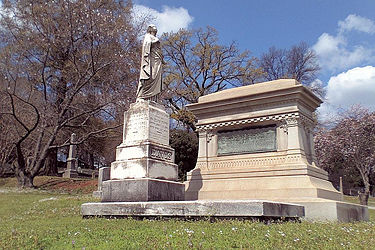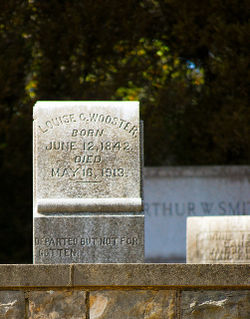Oak Hill Cemetery
- This article is about the cemetery in Birmingham. For others, see Oak Hill Cemetery (disambiguation).

Oak Hill Cemetery, located between 17th and 19th Streets and 11th Avenue and 13th Court North in Fountain Heights, is Birmingham's oldest and most distinguished cemetery. Originally 21½ acres on the estate of James M. Ware, it was already being used as a burial ground by April 1869 when it served as the resting place for the infant daughter of future mayor Robert Henley. It was marked as "City Cemetery" on the original plats for Birmingham laid out by the Elyton Land Company and was formally sold to the city on December 29, 1873 for the sum of $1,073.50.
Most of the 11,000 or so burials at Oak Hill were interred before 1905, including many early mayors, a Revolutionary soldier, numerous Civil War veterans, and the first male child born in the city. The oldest surviving marker memorializes Jesse Thompson, father of Mayor B. A. Thompson, who was buried in 1872. Although few records exist from the time, most believe the "Potter's Field" section, used by the City of Birmingham for indigent burials from 1883 to 1888, was also used as the final resting place for many victims of the 1873 cholera epidemic.
The Birmingham City Directory in 1883 states the established price of burial lots as three cents per square foot. It also warns that while no one will be forced to pay for a plot in advance of burial, if payment is not received within 60 days after death, the lot reverts back to the city. In such cases the body would be removed and reburied in the pauper burial ground. The cemetery was never formally segregated by race. Block 22 in the southwestern part of the property was set aside in the original layout for the sale of lots to Black families.
In 1889 Judge A. O. Lane coordinated the city's purchase of 200 acres on the southern slopes of Red Mountain, now known as Lane Park. That property soon succeeded the use of Oak Hill's "Potter's Field" for indigent burials. In 1896 outgoing Mayor James Van Hoose recommended that all internments at Oak Hill should cease in favor of the Red Mountain location, as having a cemetery so near to town had proven to be a mistake. He did report, though, that his administration had completed much work at Oak Hill including regrading; renewal of fencing; purchase of tools; employment of a sexton, helpers and a guard, as well as "women and boy prisoners employed and teams hired." He also noted that attorneys Gregg & Thornton "still have a number of claims in their hands for collection due on lots not paid for."
In 1913 the Oak Hill Memorial Association began to make plans for how to establish an endowment fund and a permanent organization to maintain and beautify the cemetery. Ellen DeBardeleben led those efforts. With her encouragement, a number of prominent business men took their places of what had been an all-female group. In addition to maintaining the monuments and plots of dues-paying members or donors of perpetual care depositors, and the keep the walks and grounds generally tidy, the group undertook to care for the cemetery's records. In 1928 the association relocated the caretaker's cottage from the head of the entryway at the center of the cemetery to a new site on the southwest corner and completed construction of a new "Pioneer's Memorial Building" designed by Miller & Martin Architects with William Kessler, landscape architect. The Gothic-style building, clad in Indiana limestone, contains a vaulted chapel, an office, a vault, a storage room and a restroom on the main floor, with additional storage below.
The New Deal-era Works Progress Administration carried out improvements to the cemetery in the 1930s. Later that same decade, vandals damaged the Grand Army of the Republic monument, which had been erected in 1891.
In 1977, Oak Hill Cemetery was added to the National Register of Historic Places. The Oak Hill Memorial Association keeps an office in the former caretaker's cottage and published a quarterly newsletter, the Oak Hill Pioneer, from Winter 1999 to Fall 2001, with articles about the history of the city in the context of the lives of those buried at Oak Hill. The association's executive director and cemetery superintendent is Stuart Oates.
To support the non-profit Memorial Association's mission of preserving and interpreting the cemetery site, the group organizes public tours and other events. Several burial sites are also available for purchase.
Notable burials


- William Barker (1829-1899), engineer who layed out the original plat of Birmingham
- Arthur Brown (1867-1939), pioneering Black surgeon
- John Burford, Revolutionary War veteran
- Henry Caldwell (1836–1895), physician, president of Elyton Land Company, banker
- William Elias B. Davis (1863–1903), pioneer gynecologist
- Henry F. DeBardeleben (1840–1910), industrialist and developer of Bessemer
- Frank Dixon (1892-1965), Governor of Alabama (1939-1943)
- Julia Neely Finch (1850–1926), writer and poet
- Robert Henley (1843–1873), First mayor of Birmingham, editor of the Birmingham Sun
- Goldsmith Hewitt II (1834–1895), U.S. Representative
- Andrew Johnston, railroad officer, industrialist, founder of North Birmingham
- Mortimer Jordan Jr (1844–1889), health care pioneer
- Peyton King (1826–1893), plantation owner at Avondale and attorney
- Charles Linn (1814–1882), industrialist and financier
- James Luckie (1833–1908), physician and state senator
- Alburto Martin (1830–1879), attorney and Birmingham founder
- Richard Powell McAnally (1871–1928), first male child born in Birmingham
- John T. Milner (1826–1898), railroad engineer, surveyor of Birmingham
- Willis Milner (1842–1921), engineer of Cahaba Pumping Station
- William Mudd (1816–1884), attorney, judge, Birmingham founder, builder of Arlington
- Frank O'Brien (1844–1910), manufacturer, mayor, industrialist, developer and opera-house owner
- A. H. Parker (1870–1939), educator, namesake of A. H. Parker High School
- William Pettiford (1847–1914), Baptist minister, founder of Alabama Penny Savings Bank
- Edmund Rucker (1835–1924), Civil War general, namesake of Fort Rucker, builder of the Walter Agee residence
- Fred Shuttlesworth (1922–2011), Baptist minister, Civil Rights Movement leader
- James Sloss (1820–1890), railroad magnate, founder of Sloss Furnace Company
- William H. Smith, Governor of Alabama 1868-1870
- Idyl King Sorsby (1862-1939), designer of the Flag of Birmingham
- Edward M. Tutwiler (1846–1925), railroad and mining engineer, developer
- Horace Ware (1812-1890), ironmaker and industrialist
- Louise Wooster (1842–1913), famed Madam and public health hero
- Benjamin Worthington (1814–1884), plantation owner, Birmingham founder
- Frank Yeilding (1864–1948), founder of Yeilding's department store chain
- Rosa Zinszer (1857–1930), merchant
References
- "Meeting Tuesday to Make Plans for Oak Hill Cemetery." (January 12, 1913) The Birmingham Age-Herald, p. 5
- Jeane, Gregory. "A Brief History of Oak Hill Cemetery". - accessed April 1, 2006
- Satterfield, Carolyn Green. (1976) Historic Sites of Jefferson County, Alabama. Prepared for the Jefferson County Historical Commission. Birmingham: Gray Printing Co.
- Garrison, Greg (October 21, 2011) "The Rev. Fred Shuttlesworth will be buried in Birmingham's Oak Hill Cemetery." Birmingham News
- "Birmingham's City Cemetery" in The Heritage of Jefferson County, Alabama (2002) Clanton: Heritage Publishing Consultants. ISBN 1891647547, p. 136
- Hicks, Terri L. (2013) "Oak Hill Cemetery: A Reflection of Early Birmingham, 1871-1913" M.A. thesis. UAB
External links
- Oak Hill Cemetery website
- Oak Hill Cemetery at Facebook.com
- Oak Hill Cemetery interments at the Birmingham Public Library
- The Oak Hill Pioneer newsletter